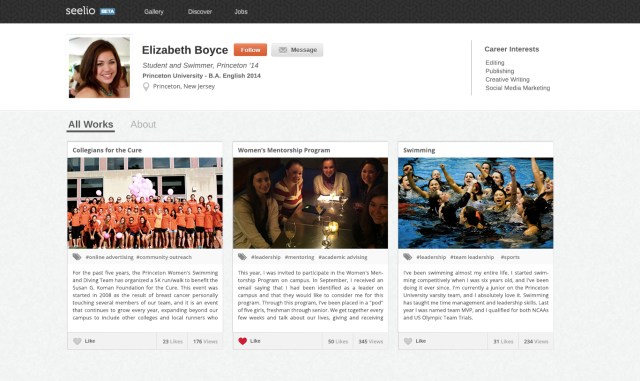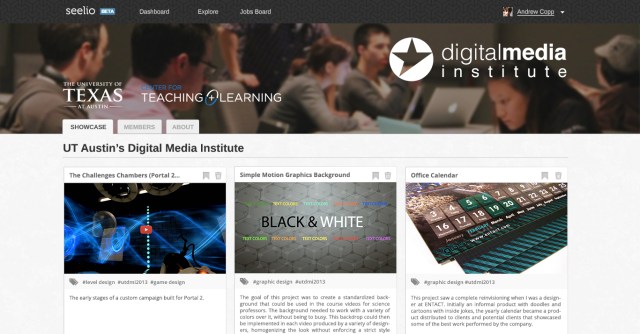Seelio, an Ann Arbor-based startup that allows students to set up an online portfolio to showcase their work in advance of having real-world job experience, has raised $900,000 in seed funding. The company had first targeted students with a .edu email address when it launched last summer, but is now expanding its platform in order to sell directly to educational institutions through a new product called Seelio for Educators.
The investment came from First Step Fund, Michigan PreSeed Fund, and a number of angels, including Steve Fireng (President and CEO of Embanet, a Pearson company), Bob Dowdell (a founder and former Chairman of the Board at careered.com), David Fry (founder of Fry Communications), and Lorne Zalesin (former CEO of MyInsuranceExpert).
Founded by University of Michigan grads Moses Lee, David Jsa, and Jerry Wang, Seelio was spun out of an existing service called TruApp, which debuted as an MVP back in January 2012. Using the university as its testing grounds, TruApp had around 1,600 students on the service before relaunching under the new branding Seelio. Today, Seelio has grown significantly, and has several more thousands of students at over 500 campuses.
Traditionally, online portfolio platforms have been built for designers and other creative types, but Seelio’s founders wanted to build something for the everyday college student. Lee explained last summer that today’s students are creating a lot of digital material that they could use to enhance their job prospects, but the problem is that traditional resumes don’t really allow them to showcase their work and capabilities.
Seelio instead allows students to customize an online portfolio featuring their work, student projects, career interests, and more, and then, even more importantly, it connects them to a job search network where employers looking for recent college grads – or even undergrads – can post jobs and message students who match their hiring needs.
Following its launch, Seelio saw traction among designers and engineers, in particular, many of whom began to show the service to faculty and administrators. Schools then started inquiring about an enterprise or white-labeled version of Seelio, says Lee.
“A lot of schools that we’ve been working with want students to graduate with a body of work so that they can show the application of their skills, rather than just a transcript,” he explains.
To date, this outreach has come from a number of big-name schools, including a program at MIT, University of Texas Austin, University of Michigan Engineering, Georgetown University, and others. There was also interest from non-traditional education programs, such as one-year courses, online outlets, and even businesses holding internal company training classes.
The team decided to build out an enterprise product for educators to meet demand. With the new platform, institutions can now choose to roll out Seelio to their entire student body, beginning with incoming freshmen. Six schools are piloting this program today, and as of this morning, the service opens to all.
Pricing for the Educator platform is based on the volume of students, and various needs they may have – like whether it’s white-labeled, for example, and other customization options. But the price generally sits at somewhere between $10-$15 per student per year, says Lee.
In addition to having students showcase their own work, the Educator platform allows the institutions to make other, more creative use of student material and projects. For example, school administrators can curate some of the publicly shared student work in order to create a collection they can feature on their website or share with alumni.
Here are a couple of examples of the Educator platform in action:
Meanwhile, on Seelio’s job network, a number of big-name tech companies have used the service to post openings, including Google, Facebook, Twilio, Twitter, and more. Students are also now pasting their Seelio URL onto their resumes, adds Lee. Companies are interested in students using Seelio, he says, because it sends a signal that the student has taken the time to build and online portfolio, and has something to show.
“They’re excited because the quality of the people on our network is strong, because this is all demonstrated works and skills,” notes Lee.
Going forward, the plan is to now further build out the Educator platform with additional analytics, allowing the institutions to see at a high level where their students are learning and what kind of work they’re doing, which could help them better tailor curricula.
The platform will also start to grow with students as they age out of their university years, letting them network with other project collaborators and prior classmates, and eventually archive older work as they create even better projects to show.
Seelio for Educators is live now, here on Seelio’s website.


